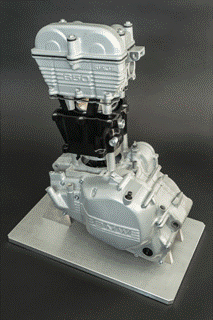Apr 3 2015
The Fraunhofer project group for new drive systems (NAS), which is part of the Fraunhofer Institute for Chemical Technology ICT, has collaborated with Sumitomo Bakelite Co. Ltd., Japan, to develop an experimental engine with lightweight cylinder casing made of fiber-reinforced composite material.
 Demonstration model of the experimental engine with lightweight cylinder casing to be presented at the Hannover Messe. © Fraunhofer ICT
Demonstration model of the experimental engine with lightweight cylinder casing to be presented at the Hannover Messe. © Fraunhofer ICT
Vehicles must become lighter if reduction in fuel consumption is to be achieved. If the vehicle’s cylinder casing and other such engine parts are made light-weight using fiber-reinforced plastic, it may help reduce weight by about 20%. Usually, aluminum is used to produce these engine parts. These plastic parts can now also be mass produced through injection-molding.
Traditionally, most car designers have tried to reduce the weight of just the body parts of the vehicles. However, the engine and the powertrain system also contribute significantly to the vehicle’s weight. Currently, the cylinder block, and other such engine components, are made of aluminum in an attempt to limit weight. Usage of fiber-reinforced plastics for certain components of the cylinder blocks will achieve an even greater reduction in weight.
“We used a fiber-reinforced composite material to build a cylinder casing for a one-cylinder research engine,” reports Dr. Lars-Fredrik Berg, who is the project leader and manager of the research area Lightweight Powertrain Design at the Fraunhofer Project Group for new drive systems. “The cylinder casing weighs around 20 percent less than the equivalent aluminum component, and costs the same.”
Though the solution seems to be easy, many technical challenges are involved. The materials to be used should be robust enough to withstand extreme vibrations, temperatures and high pressure. They should not get damaged. In the 1980s, it was discovered that plastics possessed qualities desirable for this function. However, mass production of parts, which is required for the automotive industry, was not possible. Manual labor was involved and hence this required significant effort and only small volume of parts could be produced. Cylinder blocks for vehicles are usually produced in the order of millions.
The team of researchers had to make certain that the engine would be robust enough when the material was used.
“First we looked at the engine design and identified the areas subject to high thermal and mechanical loads. Here we use metal inserts to strengthen their wear resistance,” explains Berg.
One of the parts that the team looked at was the cylinder liner. A piston inside this cylinder liner has to move millions of times when the vehicle is used. Furthermore, the geometry of these parts was altered so that the plastic was exposed to the minimal amount of heat.
The plastic material should have properties that are suitable for this role. They should have the required rigidity and hardness, and should be resistant to gasoline, oil and glycol in the cooling water. The plastic’s thermal expansion coefficient should not be higher than that of metal, and it should also adhere well to the metal inserts.
If the plastic’s thermal expansion coefficient was higher, then the inserts and substrate would get separated. Sumitomo Bakelite’s high-performance plastics business unit, SBHPP, which took part in this study, developed a glass-fiber-reinforced phenolic composite that was made up of 45% resin and 55% fibers. This material has the properties desirable for this purpose. A carbon fiber-reinforced composite would be lighter in weight, but would be more expensive. This factor will influence whether the vehicle is to be optimized in terms of weight or cost.
The researchers used granulated thermoset plastics and an injection molding process for manufacturing these components. The composite material in the melted state has both glass fibers and resin. When this material is injected it hardens in the mold of the desired shape. The optimum method of injecting the material was analyzed using computer simulations. This would also help optimize the finished product’s performance. When aluminum is used, numerous finishing operations are involved. However, the new process can be applied for mass production, and would cost less than using aluminum.
The researchers have successfully completed test runs of the new engine. “We have proved that it is capable of the same performance as conventionally built engines,” says Berg.
Furthermore, the new engine offers more advantages, including lower running noise. Preliminary data shows that when compared to aluminum-based engines, the new engine radiated lower amount of heat to the environment. The researchers intend to advance their study by developing a multi-cylinder, plastics-based engine that also included the crankshaft bearings.
At the Hannover Messe, which is to take place April 13-17 (exhibit in Hall 2, Booth C16), a prototype of this engine is to be showcased.